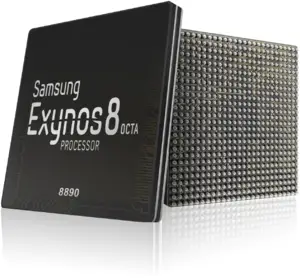From WikiChip
Editing samsung/exynos/8890
Warning: You are not logged in. Your IP address will be publicly visible if you make any edits. If you log in or create an account, your edits will be attributed to your username, along with other benefits.
The edit can be undone.
Please check the comparison below to verify that this is what you want to do, and then save the changes below to finish undoing the edit.
This page supports semantic in-text annotations (e.g. "[[Is specified as::World Heritage Site]]") to build structured and queryable content provided by Semantic MediaWiki. For a comprehensive description on how to use annotations or the #ask parser function, please have a look at the getting started, in-text annotation, or inline queries help pages.
| Latest revision | Your text | ||
| Line 36: | Line 36: | ||
|successor link=samsung/exynos/8895 | |successor link=samsung/exynos/8895 | ||
}} | }} | ||
| − | '''Exynos 8 Octa (8890)''' is a {{arch|64}} [[octa-core]] high-performance mobile SoC designed by [[Samsung]] and introduced in early 2016 for their consumer electronics. Manufactured on | + | '''Exynos 8 Octa (8890)''' is a {{arch|64}} [[octa-core]] high-performance mobile SoC designed by [[Samsung]] and introduced in early 2016 for their consumer electronics. Manufactured on a [[14 nm process]], the 8890 features [[eight cores]] consisting of a [[big core|big]] quad-core cluster operating at 2.3 GHz with a turbo of up to 2.6 GHz based on [[Samsung]]'s custom {{samsung|Mongoose 1|l=arch}} microarchitecture and another [[little core|little]] quad-core cluster operating at 1.6 GHz consisting of {{armh|Cortex-A53|l=arch}} cores. This chip supports up to 4 GiB of dual-channel 32-bit LPDDR4-3600 memory and incorporates a {{armh|Mali-T880}} MP12 GPU operating at 650 MHz. The 8890 incorporates an LTE modem supporting cat 12 download and cat 13 upload. |
| − | |||
| − | |||
| − | |||
== Cache == | == Cache == | ||
Facts about "Exynos 8 Octa (8890) - Samsung"
| base frequency | 2,300 MHz (2.3 GHz, 2,300,000 kHz) + and 1,600 MHz (1.6 GHz, 1,600,000 kHz) + |
| core count | 8 + |
| core name | Exynos M1 + and Cortex-A53 + |
| designer | Samsung + |
| family | Exynos + |
| first announced | November 12, 2015 + |
| first launched | February 21, 2016 + |
| full page name | samsung/exynos/8890 + |
| has 4g support | true + |
| has ecc memory support | false + |
| has lte advanced support | true + |
| instance of | microprocessor + |
| integrated gpu | Mali-T880 + |
| integrated gpu base frequency | 600 MHz (0.6 GHz, 600,000 KHz) + |
| integrated gpu designer | ARM Holdings + |
| integrated gpu execution units | 12 + |
| isa | ARMv8 + |
| isa family | ARM + |
| l1$ size | 384 KiB (393,216 B, 0.375 MiB) + and 256 KiB (262,144 B, 0.25 MiB) + |
| l1d$ description | 8-way set associative + and 4-way set associative + |
| l1d$ size | 128 KiB (131,072 B, 0.125 MiB) + |
| l1i$ description | 4-way set associative + and 2-way set associative + |
| l1i$ size | 256 KiB (262,144 B, 0.25 MiB) + and 128 KiB (131,072 B, 0.125 MiB) + |
| l2$ description | 16-way set associative + |
| l2$ size | 2 MiB (2,048 KiB, 2,097,152 B, 0.00195 GiB) + and 0.25 MiB (256 KiB, 262,144 B, 2.441406e-4 GiB) + |
| ldate | February 21, 2016 + |
| main image |  + + |
| manufacturer | Samsung + |
| market segment | Mobile + |
| max cpu count | 1 + |
| max memory | 4,096 MiB (4,194,304 KiB, 4,294,967,296 B, 4 GiB, 0.00391 TiB) + |
| max memory channels | 2 + |
| microarchitecture | Mongoose 1 + and Cortex-A53 + |
| model number | 8890 + |
| name | Exynos 8 Octa + |
| process | 14 nm (0.014 μm, 1.4e-5 mm) + |
| series | Exynos 8 + |
| smp max ways | 1 + |
| supported memory type | LPDDR4-3600 + |
| technology | CMOS + |
| thread count | 8 + |
| turbo frequency | 2,600 MHz (2.6 GHz, 2,600,000 kHz) + |
| turbo frequency (1 core) | 2,600 MHz (2.6 GHz, 2,600,000 kHz) + |
| turbo frequency (2 cores) | 2,600 MHz (2.6 GHz, 2,600,000 kHz) + |
| turbo frequency (3 cores) | 2,300 MHz (2.3 GHz, 2,300,000 kHz) + |
| turbo frequency (4 cores) | 2,300 MHz (2.3 GHz, 2,300,000 kHz) + |
| used by | Samsung Galaxy S7 SM-G930F +, Samsung Galaxy S7 SM-G930FD +, Samsung Galaxy S7 SM-G930S +, Samsung Galaxy S7 SM-G930K +, Samsung Galaxy S7 SM-G930L +, Samsung Galaxy S7 Edge SM-G935F +, Samsung Galaxy S7 Edge SM-G935FD +, Samsung Galaxy S7 Edge SM-G935S +, Samsung Galaxy S7 Edge SM-G935K +, Samsung Galaxy S7 Edge SM-G935L +, MicroVision MV 8890-LCD +, Meizu Pro 6 Plus +, Samsung Galaxy Note Fan Edition +, Samsung Galaxy S7 SM-G930W8 +, Samsung Galaxy Note 7 SM-N930F +, Samsung Galaxy Note 7 SM-N930FD +, Samsung Galaxy Note 7 SM-N930S +, Samsung Galaxy Note 7 SM-N930K + and Samsung Galaxy Note 7 SM-N930L + |
| user equipment category downlink | 12 + |
| user equipment category uplink | 13 + |
| word size | 64 bit (8 octets, 16 nibbles) + |